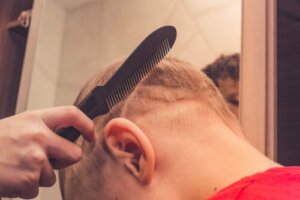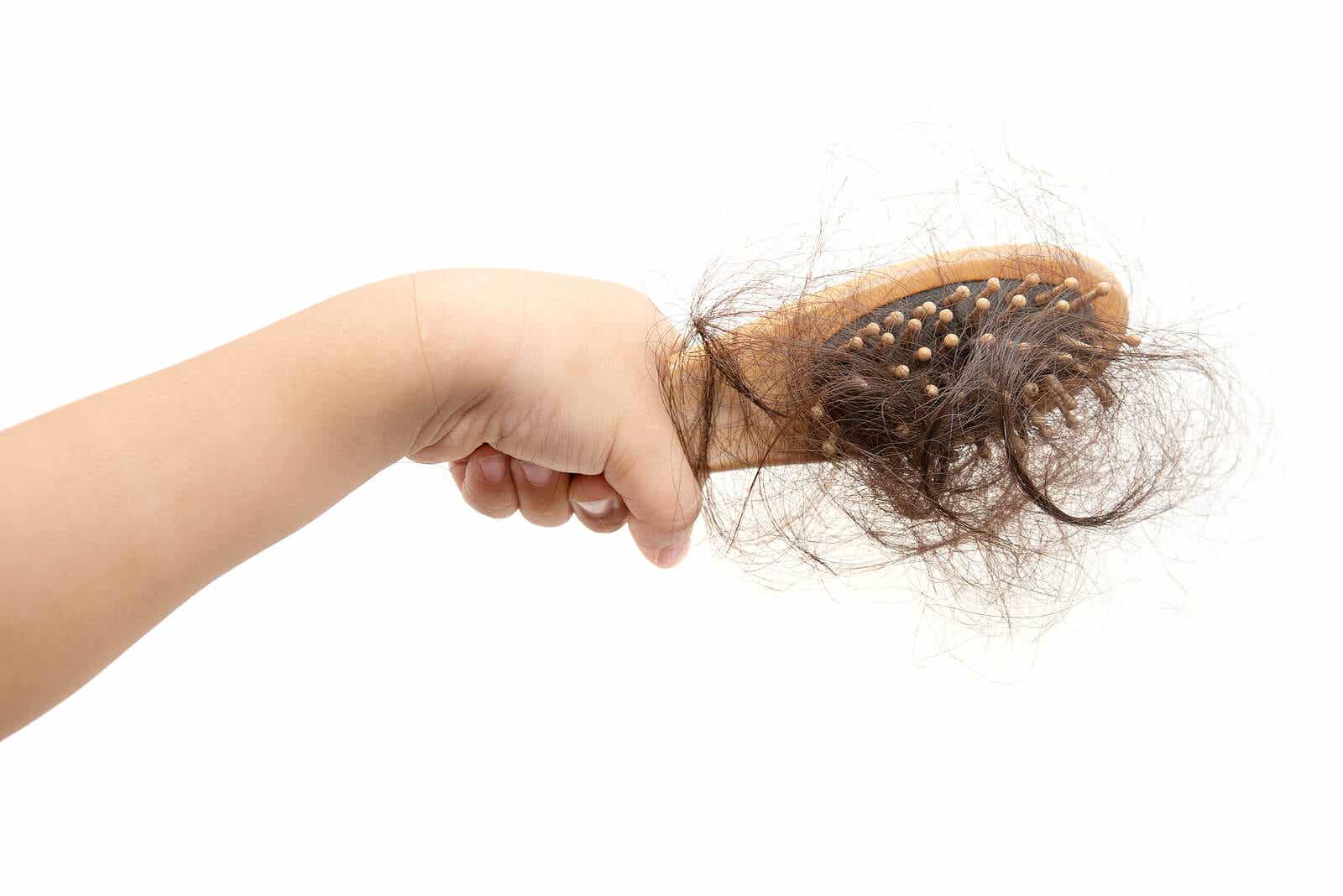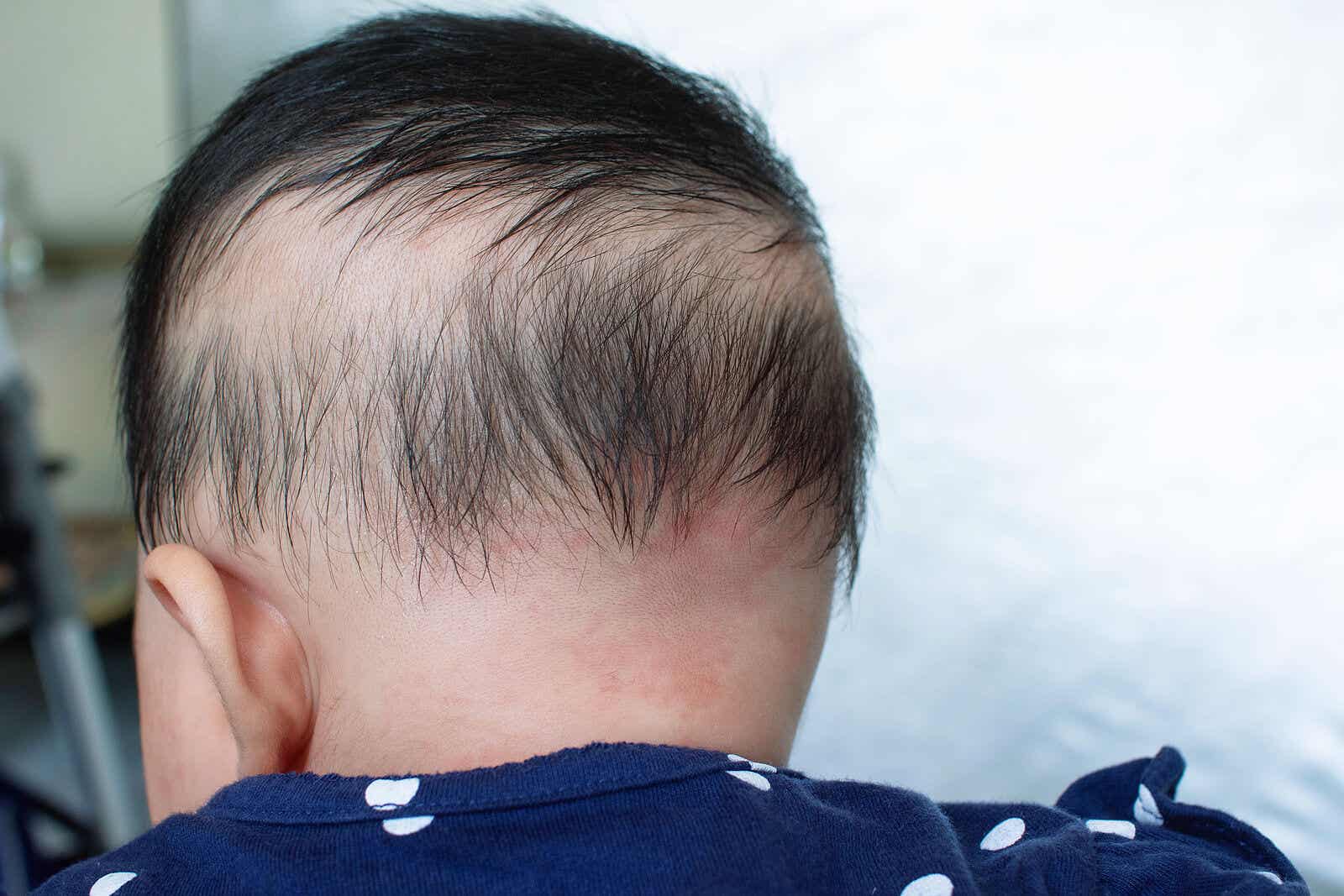Hair Loss in Children: What You Should Know


Written and verified by the dermatologist Maria del Carmen Hernandez
Hair loss in children is a relatively common problem in dermatology consultations. This can be caused by many reasons. It may have different patterns to hair loss in adults. However, in children it becomes an important issue, due the its psychological consequences.
What are the causes of hair loss in children?
Children lose hair for many reasons, such as tight buns or braids, or obsessive compulsive disorders that make children pull their hair out. The following are the most common reasons:
Alopecia areata
This is an autoimmune disease, which affects the hair follicle in the affected area. Even though it’s the main cause of hair loss in children, it also affects adults.

After healing this condition, there are no scars or residual symptoms. Furthermore, this type of disease is spontaneously solved.
It often results in a few bald spots on the scalp. This disease also relates to atopic diseases and changes in their nails.
When a first symptom appears, you should visit a specialist. In fact, a study from the Journal of the American Academy of Dermatology concluded that, when visiting the dermatologist for the first time, it’s very important to identify the degree of seriousness of the alopecia areata.
Possible treatment for alopecia areata
As we’ve mentioned before, spontaneous healing is possible. However, there are possible treatments to accelerate the healing process:
- Topical corticosteroids: this treatment is efficient in the case of moderate and serious types. Also, it’s usually the first choice, because it’s easy to administer, convenient and painless.
- Topical minoxidil: 2 or 5% minoxidil is used as a contributory treatment, in combination with topical and intralesional corticosteroids. Hypertrichosis on the face and neck is more common among children.
- Intralesional corticosteroids: there’s limited use of this kind of treatment, because it’s through the administration of injections and it causes pain.
- Topical immunotherapy: it regulates autoimmune disorders, which attack hair follicles.
Nutrient deficiencies, one of the causes of hair loss in children
According to data collected from Clinics in Dermatology, nutrient deficiency may cause changes in the structure of the hair and may also lead to hair loss. In addition, it may cause severe telogen effluvium and diffuse alopecia, seen in niacin deficiency.
Lack of iron is the most common nutrient deficiency responsible for hair loss. What’s more, other risk factors include malabsorption disorders, like celiac disease, since iron absorption requires acid pH.
Nowadays, there are different types of diets, which are becoming more and more popular. Vegans and vegetarians are more prone to iron deficiency, because they tend to consume less iron than meat eaters.
On the other hand, zinc deficiency is another cause of hair loss. And, this seems to be more common in vegetarians, because vegetables contain less zinc than meat products.
You may be interested in: Feeding Problems in Young Children
Tinea capitis
Tinea capitis is a scalp infection, caused by Trichophyton and Microsporum. It’s common in children from 3 to 14 years old. However, people from all ages can suffer from it. This infection responds quite well to systemic antifungal treatment.

The best choice is Griseofulvin for a period of 4 to 8 weeks. On the other hand, topical treatments aren’t as effective. This infection divides into two categories: inflammatory and noninflammatory.
Noninflammatory
Unlike scarring alopecia, it presents no complications. It appears as an adherent, white, diffused or patchy flake, which affects the scalp area. Sometimes, it’s difficult to identify, because it’s similar to dandruff.
Inflammatory
This type of tinea capitis can cause kerions, nodules filled with pus, just like in the case of scarring alopecia. It’s quite common to observe cervical lymphadenopathy, fever, leukocytosis, and even a diffused morbilliform rash.
You may be interested in: Scabies in Children: Symptoms, Causes and Treatment
Hair loss in children, visiting the pediatrician
Even though hair loss in children might not be important, you should always visit the pediatrician. This is because, the sooner you identify the possible problem, the faster you’ll be able to begin treatment. Remember not to use home remedies, and don’t self-medicate.
Hair loss in children is a relatively common problem in dermatology consultations. This can be caused by many reasons. It may have different patterns to hair loss in adults. However, in children it becomes an important issue, due the its psychological consequences.
What are the causes of hair loss in children?
Children lose hair for many reasons, such as tight buns or braids, or obsessive compulsive disorders that make children pull their hair out. The following are the most common reasons:
Alopecia areata
This is an autoimmune disease, which affects the hair follicle in the affected area. Even though it’s the main cause of hair loss in children, it also affects adults.

After healing this condition, there are no scars or residual symptoms. Furthermore, this type of disease is spontaneously solved.
It often results in a few bald spots on the scalp. This disease also relates to atopic diseases and changes in their nails.
When a first symptom appears, you should visit a specialist. In fact, a study from the Journal of the American Academy of Dermatology concluded that, when visiting the dermatologist for the first time, it’s very important to identify the degree of seriousness of the alopecia areata.
Possible treatment for alopecia areata
As we’ve mentioned before, spontaneous healing is possible. However, there are possible treatments to accelerate the healing process:
- Topical corticosteroids: this treatment is efficient in the case of moderate and serious types. Also, it’s usually the first choice, because it’s easy to administer, convenient and painless.
- Topical minoxidil: 2 or 5% minoxidil is used as a contributory treatment, in combination with topical and intralesional corticosteroids. Hypertrichosis on the face and neck is more common among children.
- Intralesional corticosteroids: there’s limited use of this kind of treatment, because it’s through the administration of injections and it causes pain.
- Topical immunotherapy: it regulates autoimmune disorders, which attack hair follicles.
Nutrient deficiencies, one of the causes of hair loss in children
According to data collected from Clinics in Dermatology, nutrient deficiency may cause changes in the structure of the hair and may also lead to hair loss. In addition, it may cause severe telogen effluvium and diffuse alopecia, seen in niacin deficiency.
Lack of iron is the most common nutrient deficiency responsible for hair loss. What’s more, other risk factors include malabsorption disorders, like celiac disease, since iron absorption requires acid pH.
Nowadays, there are different types of diets, which are becoming more and more popular. Vegans and vegetarians are more prone to iron deficiency, because they tend to consume less iron than meat eaters.
On the other hand, zinc deficiency is another cause of hair loss. And, this seems to be more common in vegetarians, because vegetables contain less zinc than meat products.
You may be interested in: Feeding Problems in Young Children
Tinea capitis
Tinea capitis is a scalp infection, caused by Trichophyton and Microsporum. It’s common in children from 3 to 14 years old. However, people from all ages can suffer from it. This infection responds quite well to systemic antifungal treatment.

The best choice is Griseofulvin for a period of 4 to 8 weeks. On the other hand, topical treatments aren’t as effective. This infection divides into two categories: inflammatory and noninflammatory.
Noninflammatory
Unlike scarring alopecia, it presents no complications. It appears as an adherent, white, diffused or patchy flake, which affects the scalp area. Sometimes, it’s difficult to identify, because it’s similar to dandruff.
Inflammatory
This type of tinea capitis can cause kerions, nodules filled with pus, just like in the case of scarring alopecia. It’s quite common to observe cervical lymphadenopathy, fever, leukocytosis, and even a diffused morbilliform rash.
You may be interested in: Scabies in Children: Symptoms, Causes and Treatment
Hair loss in children, visiting the pediatrician
Even though hair loss in children might not be important, you should always visit the pediatrician. This is because, the sooner you identify the possible problem, the faster you’ll be able to begin treatment. Remember not to use home remedies, and don’t self-medicate.
All cited sources were thoroughly reviewed by our team to ensure their quality, reliability, currency, and validity. The bibliography of this article was considered reliable and of academic or scientific accuracy.
- Tosti A, Bellavista S, Iorizzo M. Alopecia areata: a long term follow-up study of 191 patients. J Am Acad Dermatol. 2006 Sep;55(3):438-41. doi: 10.1016/j.jaad.2006.05.008. Epub 2006 Jun 27. PMID: 16908349.
- Goldberg LJ, Lenzy Y. Nutrition and hair. Clin Dermatol. 2010 Jul-Aug;28(4):412-9. doi: 10.1016/j.clindermatol.2010.03.038. PMID: 20620758.
- Trumbo P, Yates AA, Schlicker S, Poos M. Dietary reference intakes: vitamin A, vitamin K, arsenic, boron, chromium, copper, iodine, iron, manganese, molybdenum, nickel, silicon, vanadium, and zinc. J Am Diet Assoc. 2001 Mar;101(3):294-301. doi: 10.1016/S0002-8223(01)00078-5. PMID: 11269606.
- Gupta AK, Summerbell RC. Tinea capitis. Med Mycol. 2000 Aug;38(4):255-87. doi: 10.1080/mmy.38.4.255.287. PMID: 10975696.
This text is provided for informational purposes only and does not replace consultation with a professional. If in doubt, consult your specialist.








